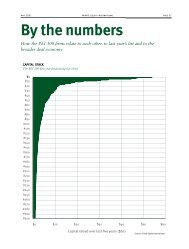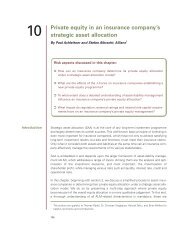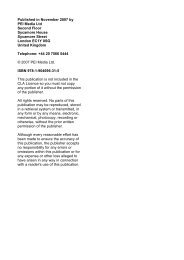Fundamentals of Private Equity and Venture Capital - PEI Media
Fundamentals of Private Equity and Venture Capital - PEI Media
Fundamentals of Private Equity and Venture Capital - PEI Media
Create successful ePaper yourself
Turn your PDF publications into a flip-book with our unique Google optimized e-Paper software.
Exhibit 7: Secondary private equity ABS structure<br />
Portfolio being securitised<br />
Undrawn<br />
commitments<br />
Investments<br />
outst<strong>and</strong>ing<br />
Financing structure<br />
Liquidity facility<br />
“AA” tranche<br />
“A” tranche<br />
“BBB” tranche<br />
“BB” tranche<br />
“B” tranche<br />
<strong>Equity</strong> tranche<br />
Bank or insurance<br />
company<br />
Structured<br />
bond buyers<br />
Purchasers <strong>of</strong><br />
residual risk<br />
Note: The difference in size between the facilities is driven by the discount <strong>and</strong> the need to over collateralise the<br />
top rated tranches.<br />
Securitised vehicles<br />
To date, most <strong>of</strong> the effort in producing structured<br />
vehicles has been in the primary market as<br />
structured fund-<strong>of</strong>-funds, but the technology<br />
developed in this area is now being applied in the<br />
secondary market. The primary goal <strong>of</strong> these<br />
structures as applied to private equity portfolios<br />
is to decrease the discount to NAV on secondary<br />
positions <strong>and</strong> to make the portfolio more marketable<br />
through the use <strong>of</strong> financial structuring.<br />
There is no common nomenclature yet for these<br />
structures, though “collateralised fund obligations”<br />
<strong>and</strong> “private fund obligations” have been used frequently.<br />
They are based on st<strong>and</strong>ard asset backed<br />
security (ABS) financial technologies that have<br />
been used for years to create securities backed by<br />
mortgages, credit card receivables, auto loans,<br />
commercial bank loans <strong>and</strong> corporate bonds.<br />
The goal <strong>of</strong> most ABS structures is to create a more<br />
efficient financing vehicle for assets by taking a<br />
large portfolio <strong>and</strong> stripping the cash flow generated<br />
by the underlying securities into different<br />
obligations. Each “strip” or tranche has different<br />
cash flow characteristics <strong>and</strong> has a credit rating<br />
that declines with each descending strip depending<br />
upon the collateral or cash flow priority held in<br />
support <strong>of</strong> that particular security. The last strip in<br />
the structure is the unrated “equity” strip, which<br />
retains all <strong>of</strong> the residual return <strong>and</strong> risk. Each<br />
strip is then sold to different types <strong>of</strong> investors on<br />
the basis <strong>of</strong> their respective risk/return appetite. A<br />
sample structure is shown in Exhibit 7.<br />
The structure outlined in Exhibit 7 differs from a<br />
typical ABS structure by the inclusion <strong>of</strong> a liquidity<br />
facility. <strong>Private</strong> equity portfolios are different<br />
from most ABS situations in that, even with a seasoned<br />
portfolio, new funding is required as commitments<br />
are drawn down. Though the early<br />
return <strong>of</strong> capital on certain investments provides<br />
a means <strong>of</strong> funding future draw-downs, it is prudent<br />
to arrange a liquidity facility or line <strong>of</strong> credit<br />
with a bank to ensure that future commitments<br />
will be met in a timely manner regardless <strong>of</strong> the<br />
realisation experience <strong>of</strong> the portfolio.<br />
Another way <strong>of</strong> looking at the structure is as a<br />
leveraged investment in private equity for those<br />
willing to invest in the equity tranche. The various<br />
tranches senior to the equity tranche effectively<br />
provide debt financing to purchase the portfolio,<br />
while the residual risks – <strong>and</strong> residual benefits –<br />
accrue to the holder <strong>of</strong> the equity tranche.<br />
To date, relatively few private equity transactions<br />
– either in the primary fund-<strong>of</strong>-funds market or in<br />
the secondary market – have been rated by the<br />
credit rating agencies. However, St<strong>and</strong>ard <strong>and</strong><br />
Poor’s, Moody’s, <strong>and</strong> Fitch’s have all established<br />
rating policies for securities collateralised by portfolios<br />
<strong>of</strong> private equity partnerships. At a summary<br />
level, the policies <strong>of</strong> all three require similar<br />
elements in order to achieve specified rating levels.<br />
These elements include, for example, pr<strong>of</strong>essional<br />
portfolio oversight, specified levels <strong>of</strong><br />
portfolio diversification, differing levels <strong>of</strong> overcollateralisation<br />
or cash flow preference, <strong>and</strong> equity<br />
protection provided by the unrated tranche.<br />
Issues with the ABS structure<br />
Fundamental issues with the ABS structure<br />
have kept it from being widely used as a means<br />
14 THE FUNDAMENTALS OF PRIVATE EQUITY<br />
COPYING WITHOUT PERMISSION IS UNLAWFUL

















